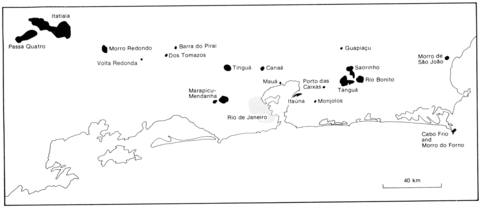stripes
This is an approximately circular intrusion covering some 50 km2 and forming hills rising to 1600 m. It is emplaced into Precambrian biotite gneisses. The complex has not been described in detail, but is formed dominantly of nepheline syenites and foyaites with dykes of tinguaite, phonolite, trachyte, augitite, limburgite, pegmatite and basalt occurring within the intrusion and up to several km from it. Phonolitic tuffs and lavas have been reported and there is probably a volcanic complex within the intrusion. The nepheline syenites are orthoclase, nepheline and aegirine-augite rocks with biotite and sodic amphibole. Phonolites consist of anorthoclase, zoned aegirine/aegirine-augite, arfvedsonite, interstitial analcime, biotite and rare eudialyte. Pseudoleucite tinguaites are found and individual pseudoleucites up to 29 cm in diameter have been described.
AMARAL, G., BUSHEE, J., CORDANI, U.G., KAWASHITA, K. and REYNOLDS, J.H. 1967. Potassium-argon ages of alkaline rocks from southern Brazil. Geochimica et Cosmochimica Acta, 31: 117-42.
LIMA, P.R.A. dos S. 1976. Geologia dos macicos alcalinos do estado do Rio de Janeiro. Semana de Estudos Geologicos, Itaguai: 205-59

